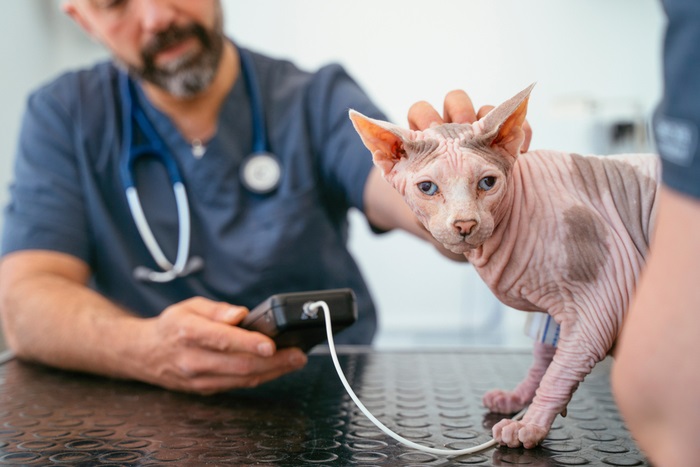
Hypertension, or high blood pressure, is an important health concern in older cats. High blood pressure in cats usually occurs secondary to an underlying disease, such as kidney disease or hyperthyroidism, and it can lead to problems like organ damage or loss of vision.
Here, we’ll discuss how hypertension affects a cat’s body, which symptoms to watch for, and how to manage the condition.
Quick Overview: High Blood Pressure In Cats (Hypertension)
 Other Names: Hypertension in cats
Other Names: Hypertension in cats
 Common Symptoms: Restlessness, lethargy, excessive vocalizing, fixed, dilated pupils, sudden blindness, wobbly walking, falling over, decreased appetite.
Common Symptoms: Restlessness, lethargy, excessive vocalizing, fixed, dilated pupils, sudden blindness, wobbly walking, falling over, decreased appetite.
 Diagnosis: Blood pressure is measured with a blood pressure cuff either manually with the Doppler method or with an automated method using an oscillometric device.
Diagnosis: Blood pressure is measured with a blood pressure cuff either manually with the Doppler method or with an automated method using an oscillometric device.
 Requires Ongoing Medication: Yes
Requires Ongoing Medication: Yes
 Vaccine Available: No
Vaccine Available: No
 Treatment Options: Treatment depends on the cause of hypertension. If present, treating hyperthyroidism will resolve hypertension. If caused by underlying kidney disease, heart disease, or an unknown (idiopathic) cause, specific blood pressure medications are prescribed.
Treatment Options: Treatment depends on the cause of hypertension. If present, treating hyperthyroidism will resolve hypertension. If caused by underlying kidney disease, heart disease, or an unknown (idiopathic) cause, specific blood pressure medications are prescribed.
 Home Remedies: None
Home Remedies: None
What Is High Blood Pressure in Cats?
Blood pressure is the amount of pressure or force exerted by blood inside of veins and arteries, measured in a unit called mmHg (millimetres of mercury).
This pressure is impacted by the heart’s rate and capacity for pumping blood, as well as by blood vessel diameter (which has some ability to expand and contract). Additionally, there is a complex feedback loop that regulates blood pressure throughout the whole body, or “systemic” blood pressure.
Like humans, blood pressure measurement in cats can include systolic pressure (when the heart contracts to pump blood) and diastolic pressure (during the resting or refilling phase of the heart’s beat). But while an average healthy blood pressure in humans is 120/80 (systolic/diastolic), those numbers run a little higher for cats.
The systolic measurement is the most important value veterinarians use to screen for systemic hypertension.
In cats, here is what systolic blood pressure readings can mean:
- <140 mmHg = Normal.
- 140-159 mmHg = Possible early hypertension, more frequent monitoring may be needed.
- 160-179 mmHg = Hypertension, cause for concern.
- >180 mmHg = Hypertension, severe risk.
If diastolic pressure is measured, anything over 90 mmHg is considered abnormal.
Causes of Hypertension in Cats
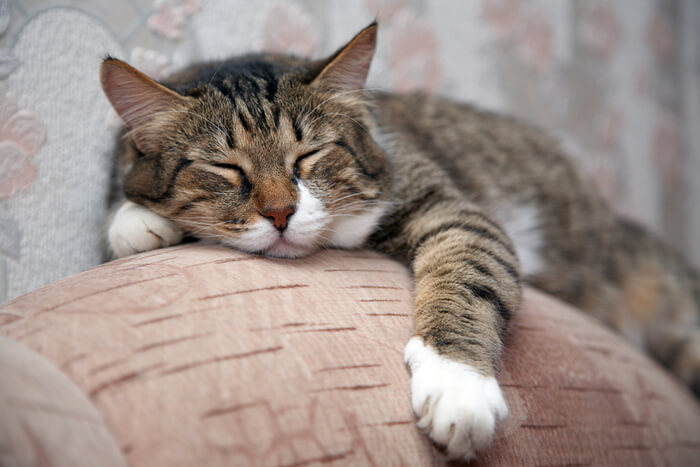
Causes of hypertension or high blood pressure in cats are divided into three categories: situational or short-term, idiopathic, or secondary hypertension.
Causes of hypertension are generally divided into three categories:
- Situational or short-term hypertension. This is when a cat’s blood pressure becomes temporarily elevated, usually due to stress or pain. For example, many perfectly healthy cats have higher-than-normal blood pressure readings due to “white coat syndrome,” or fear/stress from being at a veterinary hospital.
While usually short-term, it’s possible that sustained stress over time may contribute to a more serious blood pressure problem.
- Idiopathic or primary hypertension. This means that no underlying cause of high blood pressure was discovered. While this is typical in humans, it’s not common in cats.
- Secondary hypertension. This is by far the most common type of sustained blood pressure elevation in cats. Common causes include…
- Chronic kidney disease or kidney failure.
- Hyperthyroidism (an overproduction of thyroid hormone, usually caused by a benign tumor of the thyroid gland).
- Certain types of heart disease.
- Taking certain medications or ingesting certain toxins.
- Less commonly, diabetes mellitus or rare diseases like pheochromocytoma (a type of adrenal gland tumor).
Hypertension can affect any breed or gender of cat. Age plays a role, since older cats are much more susceptible than younger cats—which is why many vets begin routine screenings for high blood pressure in senior cats.
Symptoms of High Blood Pressure in Cats
The biggest health concern with high blood pressure is organ damage. In particular, four parts of the body are most susceptible to injury in hypertensive cats: the brain, heart, kidneys, and eyes.
Damage to these organs is called target organ damage (TOD). Avoiding TOD is a key component of blood pressure treatment.
Symptoms of hypertension in cats are often related to TOD and/or to the underlying cause of hypertension.
Clinical signs may include:
- Changes in mood or behavior, such as lethargy, restlessness, or grumpiness.
- New or unusual vocalization, especially at night.
- Urinating or drinking more.
- Vomiting
- Increased or decreased appetite.
- Weight loss.
- Weakness or fainting.
- Nose bleeds.
- A heart murmur.
- Neurological symptoms such as seizures, wobbly walking, a head tilt, or unusual eye movements.
- Sudden blindness caused by retinal detachment. When this happens, a cat may bump into furniture or other objects, or have dilated pupils that won’t constrict.
Your cat probably won’t show all of these symptoms—instead, they may just have one or two.
It’s also possible for a cat to have no obvious symptoms, especially in the early stages of hypertension.
Diagnosis of Feline Hypertension
It is possible to measure blood pressure in cats.
The most common method involves using a blood pressure cuff with either a Doppler (which detects sound in the blood vessel) or oscillometry method (which detects movement in the blood vessel). In either case, the blood pressure cuff—similar to the one your doctor or nurse would use for you, but much smaller—is placed on a limb or on the base of a cat’s tail.
Minimizing your cat’s stress helps with obtaining the most accurate measurement possible. Your vet team will take several measures to do this, including scheduling for a quiet time of the day (to avoid barking dogs, etc.), allowing your cat time to acclimate to the room, and using pheromone products or other methods to reduce stress. Also, your vet will keep your cat’s stress level in mind when interpreting the results.
Checking your cat’s blood pressure over time can help determine what’s normal for your individual cat.
Blood pressure checks may be included as part of a routine health checkup, especially for cats over 10 years of age. Other times, hypertension is discovered due to a condition like kidney disease, which raises a vet’s suspicion and alerts them to look for hypertension.
Conversely, the discovery of hypertension may prompt a vet to look for kidney disease or another underlying cause. This may require bloodwork, a urine analysis, radiographs, or other diagnostic tests, where any abnormalities can help a vet figure out what is causing the hypertension.
Treatment of High Blood Pressure
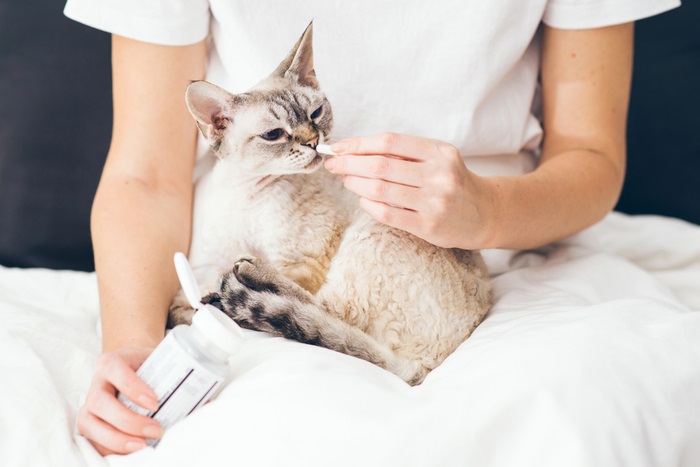
While medications can help to reduce your cat’s blood pressure, treating the underlying condition can eliminate the problem without need for blood pressure medication.
Treatment consists of two components: treating the underlying cause, and treating the high blood pressure directly to prevent target organ damage.
The good news is, sometimes treating the underlying cause will also treat the hypertension—eliminating the need for blood pressure medications.
However, some cats will need lifelong medications for hypertension.
Either way, a cat may need blood pressure medication in the short-term to prevent organ damage, until the underlying cause is under control. That’s especially true during an emergency like sudden blindness, when hypertension must be controlled immediately to give a cat their best chance of seeing again.
Medication
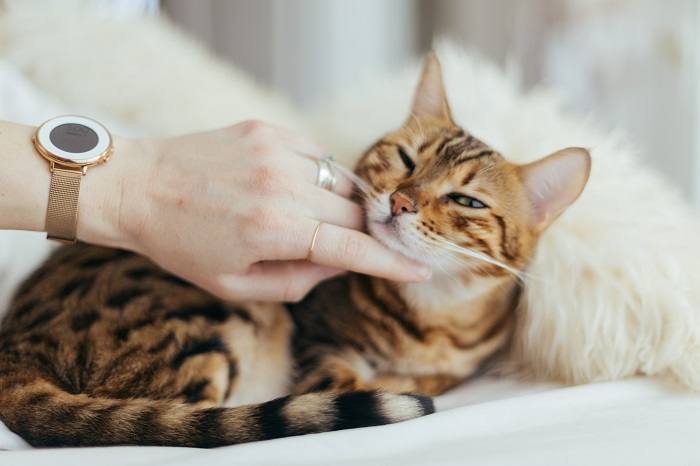
Hypersensitivity reactions can occur with any medication, but tend to be very rare for Albon use in cats.
Medications for underlying medical causes like kidney disease or hyperthyroidism vary. Some underlying causes are curable, while others require lifelong management.
To treat hypertension directly, common medications include calcium-channel blockers (amlodipine) and angiotensin-converting enzyme inhibitors (benazepril and enalapril). Both of these medications work by relaxing the smooth muscles of the blood vessels and dilating them to relieve pressure. There are other types of medications out there, too, but these are the most common.
Follow your vet’s instructions exactly, and monitor for any side effects, such as decreased appetite, stomach upset, drowsiness, or symptoms of low blood pressure (wobbly walking, fainting, collapse, or weakness).
Long-term blood pressure checks are also a key part of treatment.
There’s no standard medication dose that works for all cats, and a cat’s dosage needs may change over time. So it’s important to follow up as your vet recommends to ensure the medicine is working for your cat.
The first recheck will be soon after starting medication (usually within 7 days). Then rechecks will become less frequent as your cat’s blood pressure stabilizes.
Diet for High Blood Pressure in Cats
There is no specific diet for hypertension. Instead, diet is usually addressed at the underlying cause, such as kidney disease or hyperthyroidism.
In general, it may be best to avoid excessive sodium intake. But it’s best to ask your vet for an individual recommendation.
Read More: Best Cat Food for Seniors
Prognosis
Hypertension in and of itself is not fatal, assuming it is addressed in a timely fashion and well-managed over the long-term.
However, the damage to important organs caused by hypertension can be fatal. Organ damage may be permanent if treatment is delayed, and uncontrolled hypertension can lead to kidney or heart failure or even to a stroke.
Prognosis also depends on the underlying cause of hypertension. Some conditions can be cured, allowing a cat to live a normal life. Some underlying diseases are fatal, but some can be managed for a very good quality of life for months or even years.
Conclusion
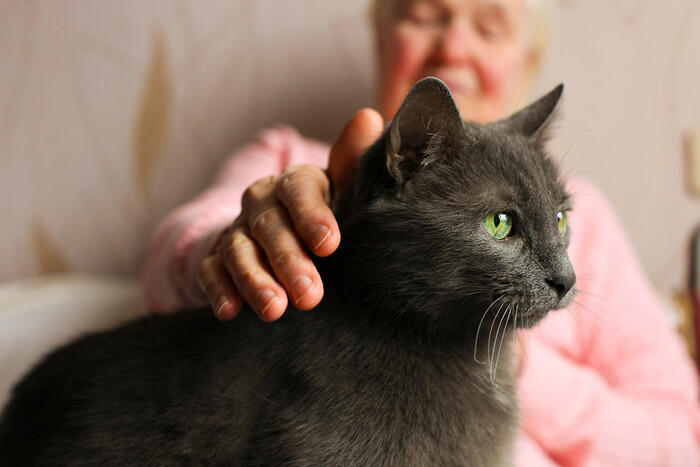
Your cat’s blood pressure is influenced by the heart and blood vessels. A complex feedback loop regulates blood pressure throughout the entire body.
High blood pressure is a relatively common condition in older cats that usually occurs secondary to another health problem like kidney disease or hyperthyroidism. It’s important to address high blood pressure, since it can cause damage to the brain, eyes, kidneys, and heart. Routine blood pressure screenings may be recommended for cats over 10 years of age.
Frequently Asked Questions
What are the symptoms of high blood pressure in cats?
Common symptoms associated with hypertension include behavior or mood changes, unusual vocalization and restlessness, urinating or drinking more, changes to appetite or weight, weakness, neurological symptoms, and sudden blindness. Some cats might not show any symptoms in the early stages.
What causes high blood pressure in cats?
Most commonly, sustained high blood pressure occurs secondary to another condition, such as chronic kidney disease or hyperthyroidism. Stress or pain may cause a temporary blood pressure elevation.
How can I lower my cat's blood pressure?
Treatment for high blood pressure involves working with your vet to address the underlying cause, and possibly giving anti-hypertensive medications.
What should a cat's blood pressure be?
A cat’s systolic blood pressure (the measurement while the heart contracts) should be below 140-150 mmHg. Anything above 160 mmHg is a concern, and anything over 180 mmHg carries a high risk of organ damage.








Hi, do you have any recommendations for an at home blood pressure monitoring device for cats? Thanks!
Hi Ree,
We have tested any devices to date, I could find something really good searching online to be honest, this seems decent:
https://www.amazon.com/Automatic-CONTEC08A-VET-Electronic-Sphygmomanometer-Tonometer/dp/B07D6GZWH5
Did you ask your vet?
Five year old small cat wen for severe Pododermatitis treatment, kidney failure discovered. Dr says Pododermatitis is immune system related. Prescribed Benezepril, but is this safe in high Proteinuria cats ? Cat limps from surgery on paw two weeks should he be on more antibiotics? The only problem this rescue ever had was small weight and frequent eater. Dr did not check thyroid? Could sudden kidney discovery be infection as red cells found in test?
Hello Drina, unfortunately, this question is a bit out of my depth. I would ask the vet for more information, as they know a lot more about your cat’s diagnosis, history, and condition. However, I would note that Benazepril is known to reduce proteinuria in addition to lowering blood pressure, which is generally considered a good thing. Elevated red blood cells can be caused by kidney inflammation, injury, and infection, so I would consult the veterinarian to learn what, exactly, led them to this diagnosis. Hope this points you in the right direction.
Hi,
My cat was almost 20 years old.
In March she was diagnosed with the beginning of renal failure and was given medication. She also lost her eye sight…which I attributed to age.
In November, she was eating and drinking a lot…along with vocalizing in the middle of the night. She is a Birman and often did that so I was not overly concerned.
3 weeks ago, on a Thursday, I decided to take her to my vet. He said she had kidney failure. He gave me an IV to administer every other day.
On Monday, I came downstairs and she was laying on the floor. I thought she was dead. I picked her up and it was obvious she had a stroke.
I rushed her to my vet and his assistant handled everything. She did a blood test and gave her oxygen. She confirmed my cat had a stroke and my vet and his associate suggested to put her to sleep so I did.
I am now reading about high blood pressure, etc.
Do you believe I did the right thing…I am extremely sad after I read this article.
Thank you.
Gail Kross
Hi Gail, it’s natural to feel sad after reading this article and thinking over whether or not you did the right thing. I’m not a veterinarian, and I’m not sure how advanced your kitty’s renal failure was or how severely she was affected by the stroke. It’s impossible to say what might have been if you’d make a different decision. That said, the fact that both your veterinarian and his associate recommended euthanasia does suggest that it was an appropriate time. I understand that you’re ruminating over what happened, and that’s completely natural. For now, you might get some comfort from this article on the right time to euthanize your cat. And once you’ve read that, consider this one on coping with the loss of a cat. Wishing you all the best.